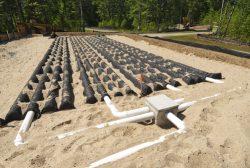Leach Field: What Is It and How Does It Work?
 Leach Field: What Is It and How Does It Work?
Leach Field: What Is It and How Does It Work?
If you own a septic system, you may have heard of a leach field or drain field. A leach field is an essential component of a septic system, and it plays a vital role in the disposal of wastewater. In this blog post, we’ll take a closer look at what a leach field is and how it works.
What is a Leach Field?
A leach field, also known as a drain field, is a crucial component of a septic system. It’s a series of perforated pipes buried in trenches in the soil. The pipes are typically laid out in a grid pattern, and they are surrounded by gravel or other porous materials. The pipes are designed to distribute wastewater from your septic tank evenly throughout the leach field. Once the wastewater reaches the leach field, it percolates through the soil, where it is naturally filtered and purified.
How does a Leach Field work?
A leach field is responsible for treating the wastewater that flows through your septic system. After the wastewater exits your home and enters your septic tank, it undergoes a series of treatment processes. The solids in the wastewater settle to the bottom of the tank, where they are broken down by bacteria. The liquid portion of the wastewater, which is mostly water and small particles, is then discharged to the leach field.
When the wastewater reaches the leach field, it enters the perforated pipes and is distributed evenly throughout the drain field. The wastewater then percolates through the soil, where it is naturally filtered and purified. The soil acts as a biological filter, removing harmful bacteria, viruses, and other contaminants from the wastewater. The natural filtration process removes up to 99% of bacteria and viruses, leaving the water cleaner and safer for the environment.
Proper Maintenance of Leach Field
Proper maintenance of your leach field is crucial to ensure the long-term effectiveness and efficiency of your septic system. Here are some tips for maintaining your leach field:
1. Regular Pumping of Septic Tank: Regular pumping of your septic tank is essential to prevent solids from entering the leach field. Solids that are not removed from the tank during pumping can clog the pipes in the leach field, resulting in a malfunctioning system.
2. Be Careful of What Goes into Your Septic System: Be mindful of what goes into your septic system. Avoid flushing non-biodegradable materials, such as wipes, feminine hygiene products, and diapers. These items can clog your septic system, leading to costly repairs and damage to your leach field.
3. Minimize Water Usage: Excessive water usage can overload your septic system and cause issues with your leach field. Be mindful of your water usage and take steps to conserve water.
4. Do Not Park or Drive on Your Leach Field: Never park or drive heavy equipment on your leach field. Doing so can damage the pipes and affect the natural filtration process of the soil.
5. Regular Inspection of Septic System: Regularly inspect your septic system for signs of damage or malfunction. Catching issues early can prevent costly repairs and prolong the life of your septic system.
Conclusion
A leach field is an essential component of a septic system, and it plays a crucial role in the natural filtration and purification of wastewater. Regular maintenance and proper usage of your septic system are crucial to ensure the long-term effectiveness and efficiency of your leach field. Be mindful of what goes into your septic system, conserve water, and regularly inspect your system for signs of damage or malfunction. Proper maintenance of your leach field can ensure a safe and environmentally friendly disposal of your wastewater for years to come.
Got questions about your leach field or septic system? Let us help! Contact us today to learn more about what we can do for you!
Categorised in: Leach Fields, Septic Systems
This post was written by admin

 Leach Field: What Is It and How Does It Work?
Leach Field: What Is It and How Does It Work?